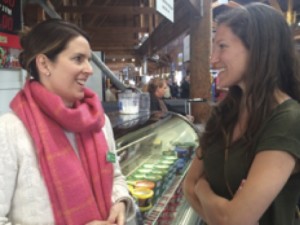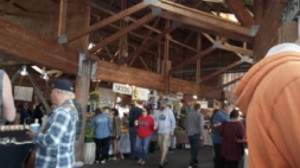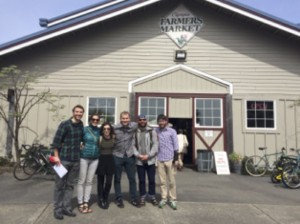By Sadie DiNatale
This last weekend, our CPW project team headed north to Olympia, WA to gain insight on how an existing public market operates. For context, a public market is a permanent facility, often serving as a small business incubator, which provides an opportunity for vendors to sell local goods such as produce, prepared food and beverages, and DIY crafts and art. Our CPW project involves the development of a feasibility assessment for a permanent public market in downtown Eugene. As such, this trip was a critical component to enhance our team’s understanding of how a public market functions in real time. This trip also provided us with an opportunity to participate in in-person interviews with a market representative and a variety of vendors.
CPW project involves the development of a feasibility assessment for a permanent public market in downtown Eugene. As such, this trip was a critical component to enhance our team’s understanding of how a public market functions in real time. This trip also provided us with an opportunity to participate in in-person interviews with a market representative and a variety of vendors.
Upon arrival at the Olympia Farmers Market we partook in a self-guided tour. We assessed the number and types of vendors, looking at who sold what and how different vending booths or businesses complimented each other. We wondered if there was competition or contentious feelings between vendors selling similar products. We quickly learned from interviewing Mary (the market representative) that this was not the case as market comradery and vendor pride mitigated these feelings.
 While on our tour we also used a keen eye to assess the design elements of the facility and its spatial context. The facility was impressive with wide aisles (10’ to 12’) and open walls allowing air and patrons to flow to and fro. The ceilings were high which further mitigated feelings of claustrophobia. We learned from Mary that these high ceilings serve a dual purpose which was not only to provide an open atmosphere but also to allow for phased expansion in the future.
While on our tour we also used a keen eye to assess the design elements of the facility and its spatial context. The facility was impressive with wide aisles (10’ to 12’) and open walls allowing air and patrons to flow to and fro. The ceilings were high which further mitigated feelings of claustrophobia. We learned from Mary that these high ceilings serve a dual purpose which was not only to provide an open atmosphere but also to allow for phased expansion in the future.
While interviewing vendors, our team gained additional insight into the various attitudes and opinions of vendors both new and senior. When discussion governance, vendors enjoyed that the market was vendor-managed and that there was both a community member on the board of directors as well as a member with business expertise. Vendors loved that there was an assortment of products sold and that it brought a diversity of people to the market. They loved that the market was an enclosed space which allowed them to skip the hassle of setting up tents daily. Most especially, they loved the community spirit that rang throughout the market regularly. 
Just as important, we learned about the challenges that vendors faced. For instance, they stressed the necessity of having all vendors follow an organized process during set up and take down of their booth displays. They discussed concerns over fee structures for different categories of vendors and of parking constraints that intensified when other City events fell on market days.
All in all, our team had a great time as the carnival-like atmosphere of the market made our work an incredibly joyous occasion. Assessing how our prior knowledge (gained from case study research and  surveying) measured up to the operations, concerns, and strengths of an existing public market was thought-provoking. On the ride back to Eugene we discussed how this new knowledge would translate into our feasibility report.
surveying) measured up to the operations, concerns, and strengths of an existing public market was thought-provoking. On the ride back to Eugene we discussed how this new knowledge would translate into our feasibility report.
Ultimately, we left with a renewed sense of appreciation for successful, functional public markets—not just for the benefits offered to patrons and vendors but for the community and economic development potential for the city as a whole. Although planning and development of a public market is still in the very early stages for Eugene, our team hopes to convey these new insights in our report in hopes that Eugene may one day soon reap the benefits of a public market.
Sadie DiNatale
Sadie is currently a candidate of the Masters of Community and Regional Planning program. Her professional and academic interests include neighborhood and community development.
